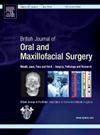Dental prophylaxis and alloplastic temporomandibular joint replacement (TMJR): time for a consensus?
IF 1.9
4区 医学
Q3 DENTISTRY, ORAL SURGERY & MEDICINE
British Journal of Oral & Maxillofacial Surgery
Pub Date : 2025-06-01
DOI:10.1016/j.bjoms.2025.04.001
引用次数: 0
Abstract
Searches of the literature and current guidelines have revealed inconsistent recommendations regarding dental optimisation prior to alloplastic temporomandibular joint replacement (TMJR). Furthermore, current literature suggests there is no consensus on antibiotic prophylaxis (AP) for dental procedures following TMJR. A 12-question survey was emailed to Professor Mercuri’s TMJ Internetwork Group (144 members) and The European Society of Temporomandibular Joint Surgeons (ESTMJS) (49 members), totalling 177 survey recipients, accounting for those who are members of both groups. Respondents were asked whether routine dental assessments were performed prior to TMJR, if they recommended AP following TMJR, the timeframes and types of procedures for which this was recommended, and the types of antibiotics prescribed. The survey had 50 respondents, as of 15 November 2024, giving an overall response rate of 28.2%, however, the question specific response rate ranged from 29 to 50 respondents. No consensus was reached regarding the types of AP recommended, with 54.2% (n = 26) of respondents offering no prophylaxis for dental treatment following TMJR. The majority of respondents who did provide prophylaxis preferred amoxicillin or co-amoxiclav (n = 25/37), and clindamycin for penicillin allergic patients (n = 13/46). The timeframe for which respondents felt that antibiotics should be offered for dental procedures post-TMJR varied from one month (n = 3/37) to lifelong (n = 6/37), with a modal response of two years (n = 9/35). This survey reflected the lack of consensus seen across available literature and highlights the need for unified guidance to ensure safe and consistent patient care for TMJR patients.
牙齿预防和同种异体颞下颌关节置换术(TMJR):是时候达成共识了?
对文献和现行指南的搜索显示,在同种异体颞下颌关节置换术(TMJR)之前,关于牙齿优化的建议不一致。此外,目前的文献表明,对TMJR后牙科手术的抗生素预防(AP)没有共识。一份包含12个问题的调查通过电子邮件发送给麦科利教授的TMJ网络小组(144名成员)和欧洲颞下颌关节外科医生协会(ESTMJS)(49名成员),共有177名调查对象,其中包括两个小组的成员。受访者被问及是否在TMJR之前进行常规牙科评估,他们是否在TMJR之后推荐AP,推荐的时间框架和程序类型,以及处方的抗生素类型。截至2024年11月15日,该调查共有50名受访者,总体回复率为28.2%,然而,具体问题的回复率在29至50名受访者之间。对于推荐的AP类型没有达成共识,54.2% (n = 26)的受访者在TMJR后没有提供牙科治疗预防。大多数提供预防措施的应答者更倾向于阿莫西林或联合阿莫西拉夫(n = 25/37),而青霉素过敏患者更倾向于克林霉素(n = 13/46)。应答者认为tmjr后牙科手术应提供抗生素的时间范围从1个月(n = 3/37)到终生(n = 6/37)不等,模态反应为2年(n = 9/35)。这项调查反映了现有文献中缺乏共识,并强调需要统一指导,以确保TMJR患者的安全和一致的患者护理。
本文章由计算机程序翻译,如有差异,请以英文原文为准。
求助全文
约1分钟内获得全文
求助全文
来源期刊
CiteScore
3.60
自引率
16.70%
发文量
256
审稿时长
6 months
期刊介绍:
Journal of the British Association of Oral and Maxillofacial Surgeons:
• Leading articles on all aspects of surgery in the oro-facial and head and neck region
• One of the largest circulations of any international journal in this field
• Dedicated to enhancing surgical expertise.

 求助内容:
求助内容: 应助结果提醒方式:
应助结果提醒方式:


